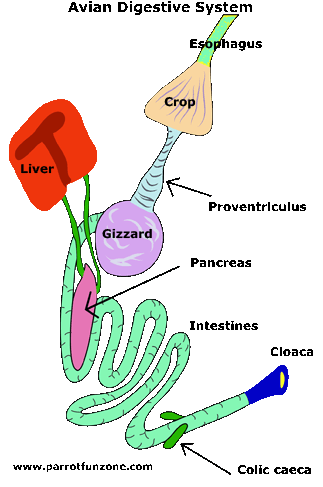Avian
Physiology: Circulation, Respiration,
and Digestion
Hummingbird heart rates can reach 1200
beats per minute, and their breath rate can be 250 times per minute. Parrots need a mere 15 to 20 minutes to fully
digest a meal. In addition, all birds
have a special organ called the ventriculus, commonly known as the gizzard,
which grinds food that passes through the proventriculus (stomach). Unlike other animals, many birds have a special
part of their respiratory systems called air sacs, which serve a special function. Birds have some of the most efficient and
unique digestive, circulatory, and respiratory systems in the animal kingdom.
Avian digestion is special in the
animal kingdom because the system uses two organs that most other animals do
not have. The organs are called the crop
and the gizzard. The crop is the first organ in the digestive process, and the
second organ is the proventriculus or the stomach. The proventriculus starts the digestive
process by breaking the food down with hydrochloric acid. The acid softens the food for the gizzard. Then, the gizzard grinds the food using strong
muscles like a person’s mouth would chew food. Some birds will eat small stones to help their
gizzards to grind hard food. Next, the
food enters the small intestine. The
small intestine receives bile from the liver and the pancreas to counteract the
acid. The large intestine is a very
small part of the digestive process and absorbs the remaining nutrients and
water. The final step is the cloaca
where the waste and urine are mixed and excreted. For most birds, the whole digestive process
takes approximately 40 minutes. This is very fast compared to human digestion.
Humans take about six to eight hours to digest a meal.
The avian respiratory system is different
than humans and other mammals because of organs called air sacs. Birds are the
only type of animal with these organs. They
help birds inhale and exhale because birds do not have a diaphragm muscle. The
air sacs allow birds to collect more oxygen because less old air remains in the
lungs. The air sacs give a bi-directional
airflow. When the bird inhales, the air
passes through the lungs and goes to the air sacs. When it exhales, the air from the air sacs
pass the lungs again and gives the bird more oxygen. Birds have small lungs
compared to other animals. One bird
called the Bar-Headed Goose can fly as high as 23,000 feet above sea level where
humans cannot breathe.
Bird circulatory systems are efficient
because they are is strong enough for the birds to fly. Birds are warm-blooded, and their hearts have
four chambers: two atria and two
ventricles. The ventricles pump blood to the body while the deoxygenated blood
enters the atria. The right ventricle pumps blood only to the lungs and the
left ventricle pumps the blood to the rest of the body. Birds’ hearts are relatively larger than
mammalian hearts so they can move their wings fast enough to fly. With larger hearts they can pump more blood
and get more oxygen. There are five kinds of vessels in their circulatory
system: arteries, arterioles,
capillaries, veins, and venules. The arteries carry blood from the heart. The
arterioles distribute blood where it is needed in the body, including the more
active tissues. The capillaries exchange
nutrients and waste. Finally, the
venules and veins take blood back to the heart.
Overall, birds have some of the most
efficient and unique physiology to help them achieve the hard task of flying. Birds have adapted to collect more oxygen and
nutrients to survive. They can eat more food at a time because of their crop. They
have air sacs which allow them to gain oxygen while breathing in and out. They have bigger hearts so the heart can pump
more blood. With this physiology a bird
could even be the next dominant species.





Comments
Post a Comment